Table of Contents
A thermocouple is one of several devices used to measure temperature. It is used the most in the industry due to its simple construction and easy use. Thermocouples are made by joining the ends of two different metal wires. It is also known by many other names.
The thermocouples works on the Seebeck effect. The Seebeck effect was discovered in 1821 by the German scientist Thomas Johann Seebeck.
When two joints of two different metal wires are kept at different temperatures, current starts flowing through the wire. This is called the Seebeck effect. And the electromotive force produced in the circuit is called thermal electromotive force.
Thermocouple Principle:-
According to Thomas Johann Seebeck, when two different metal’s wires are joined together, one is heated and one is cooled, then an electromotive force arises between them, which is proportional to the temperature difference. Which is measured in galvanometer, the electric carrying force generated is very small which is in mV.
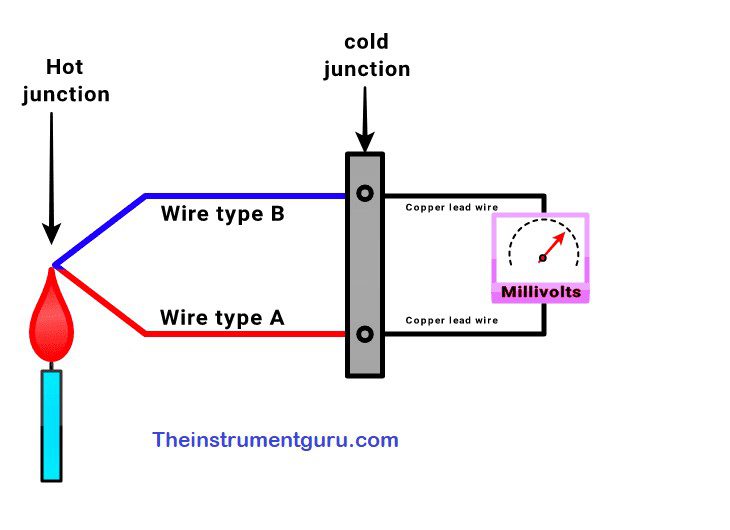
The standard table is used to measure the temperature by mV. Since thermocouples are made by combining different types of wires, the voltage generated by them is also different. Therefore, certain combinations of different metals have been divided on the basis of the type of thermocouple and a standard table has been prepared for each. By which the temperature can be determined.
Thermocouples are mostly used for measuring temperature in industry because it is cheap, easy to use, more reliable, more temperature range. There are many types of thermocouples available in the industry. This is very important to recognize.
To identify them, it is necessary to know about their types.
Thermocouple types :-
There are many types of thermocouples according wire metallurgy in instrumentation industry that is given below.
K- Type Thermocouple:-
K-type is the most usable type of thermocouples, and it’s measuring range is too wide.
K-type thermocouple Positive lead is yellow in color and is a non-magnetic material. Negative lead is red in color and is a magnetic material. And the overall jacket is yellow in color.
Yellow lead of a Type K T/C is composed of approximately 90% nickel and 10% chromium. Red lead is composed of approximately 95% nickel, 2% aluminum, 2% manganese and 1% silicon.
The K type TC has a temperature range of -200˚C to +1260˚C (-328 F to +2300 F). It is inexpensive and widely used in general purpose applications where temperature sensitivity of approximately 41μV/C is required.
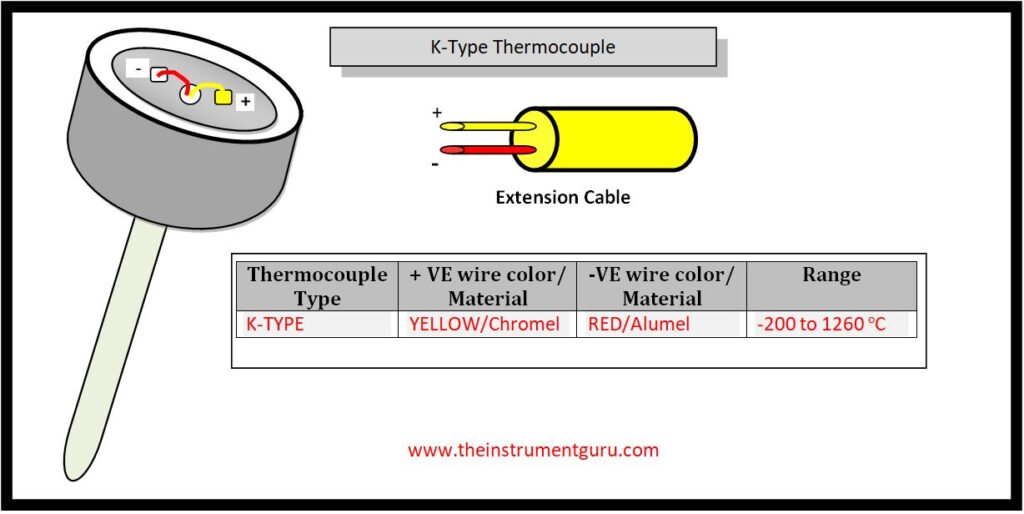




The accuracy of the K type T/C is ±2.2C% (0.75%). The accuracy of the TC also depends on the deviations in the alloys.
K Type thermocouples perform best in a clean oxidizing environment. It is not recommended to be used for partially oxidized conditions in vacuum.
T-Type Thermocouples:-
This type of thermocouple is suitable for measuring low temperatures. The positive lead is made of copper and the negative lead is made of constantan (45% nickel and 55% copper).
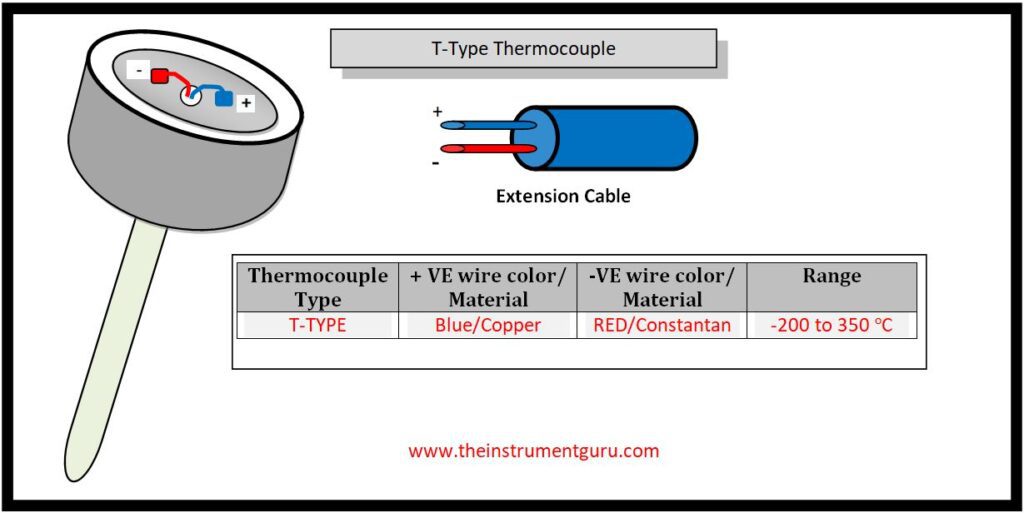




The T type TC has a sensitivity of 43 µV/°C. This type T/C is suitable for working in oxidizing environment. The temperature range of this thermocouple is between -200°C to 350°C.
J-Type Thermocouple :-
This type of thermocouple is a low cost and most commonly used T/C. Positive lead is made of iron and negative lead is made of constant (45% nickel and 55% copper).
The positive lead is colored white and the negative terminal is colored red. And the overall jacket is of black colour.
The J type TC has a temperature range between 0˚C to 760˚C. This type of T/C has a shorter temperature range and shorter life span than the K type . But this type of TC is well suited for oxidizing environment.
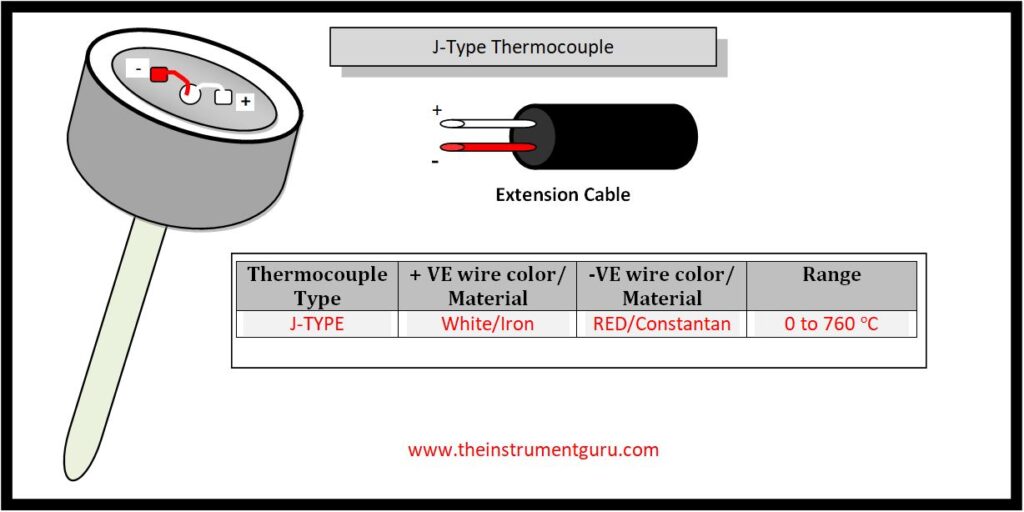




J type T/C has an accuracy of ±2.2˚C (0.75%). This type of thermocouple is not recommended for low-temperature applications. And the sensitivity of this type of thermocouple is about 50μV/˚C.
E-Type T/C :-
This type of thermocouple has higher accuracy and stronger signal than K and J thermocouple over medium temperature range. And it is more stable type TC than type K. The Type E T/C produces the highest emf per degree compared to other types of thermocouples.
The positive lead is composed of nickel-chromium (90% nickel and 10% chromium) and a negative terminal constant (95% nickel, 2% aluminum, 2% manganese, and 1% silicon). The color of positive lead is purple and that of negative lead is red.





The temperature range of this type of TC is between -270˚C to 740˚C . And the standard accuracy is ±1.7˚C%.
This type of T/C is used where high accuracy and fast response is required. It is not used for vacuum or low oxygen applications and sulfuric environments. The cost of E type thermocouple is more than J and K type .
N-Type T/C :-
The N-Type thermocouple was developed by the Defense Science and Technology Organization (DSTO) of Australia by Noel A. Designed by Burley. The accuracy and temperature range of a N type T/C are the same as that of a type K TC.
The temperature range of Type N thermocouples is between -270 °C and 1300 °C. The sensitivity is slightly less than a Type K thermocouple and is 39μV/˚C.
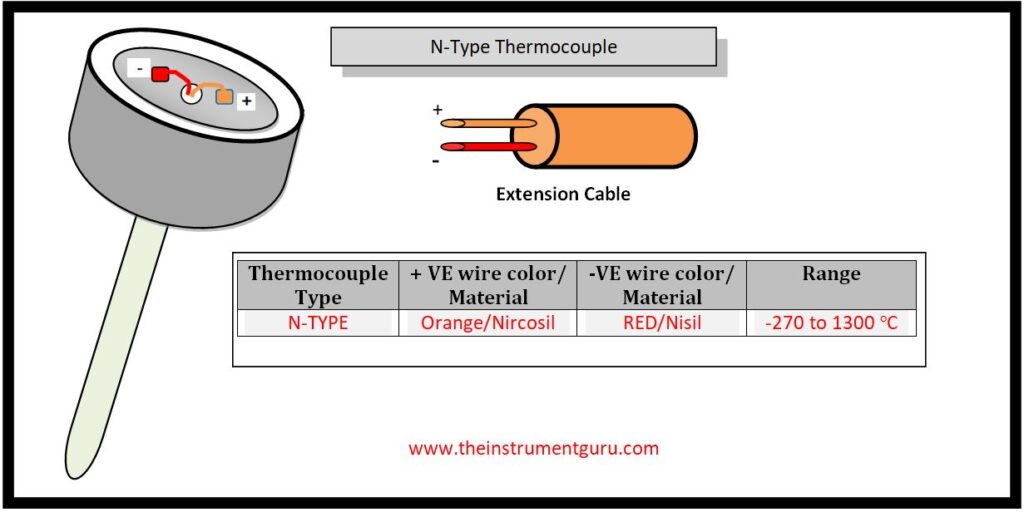




The Type N thermocouple is composed of Nicrosil and Nisil. Where nicrosil is a mixture of nickel, chromium and silicon. And this made the positive wire. Nisil is a mixture of nickel and silicone. And it made a negative wire.
This thermocouple is the best choice for type K thermocouple for low oxygen conditions. This type of thermocouple is suitable for use in vacuum, oxidizing environments, inert environments or dry environments.
S-Type Thermocouples :-
Type S thermocouples are used for high temperature applications. Due to the high accuracy and stability, it is sometimes also used for low temperatures.
The temperature range of S type T/C is between -50 °C to 1768 °C. Positive lead is made up of 90% platinum, 10% rhodium and negative lead is made of platinum.
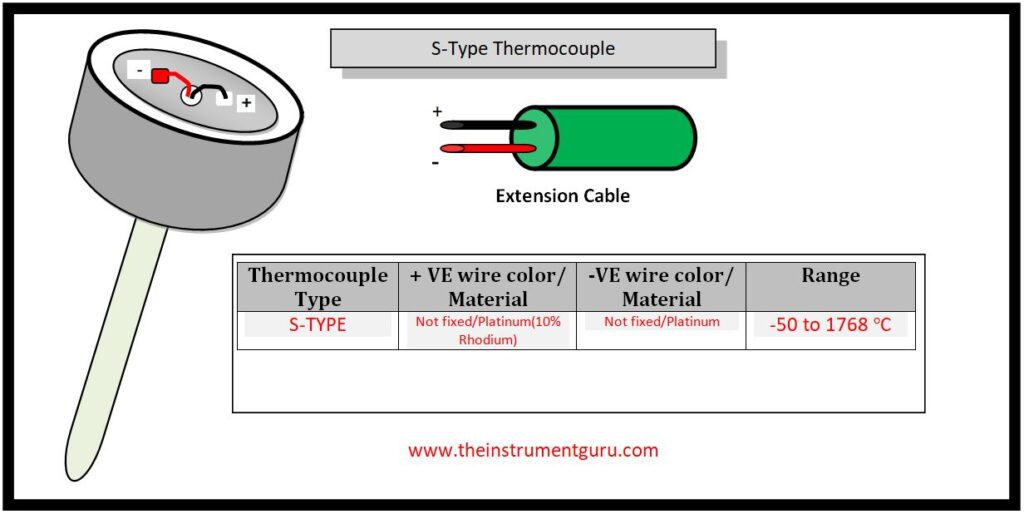




Typically, this type of TC is used in applications such as the pharmaceutical and biotech industries where high temperatures must be measured with high accuracy.
R-Type Thermocouple :-
The R-Type thermocouples are also made of platinum and rhodium. But the output range and stability of Type R thermocouple is slightly higher than that of Type S thermocouple.
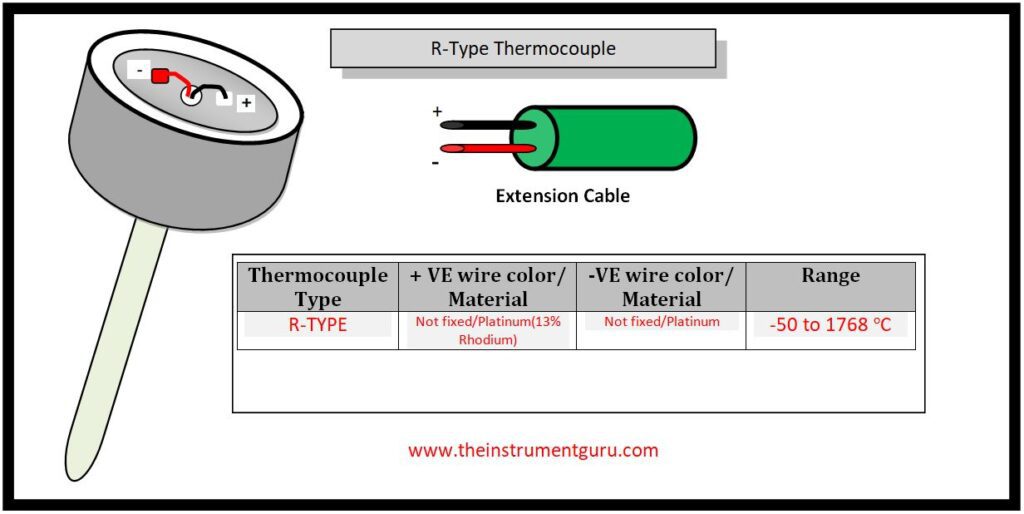




The positive lead PF Type R thermocouple is composed of 87% platinum and 13% rhodium. And the negative lead is made of platinum. The temperature range of this thermocouple is between -50 °C to 1768 °C.
B-Type Thermocouples :-
Type B thermocouples are also made from a combination of platinum and rodeom. The positive lead of a thermocouple is composed of 70% platinum and 30% rhodium. And negative lead is made up of 94% platinum and 6% rhodium.
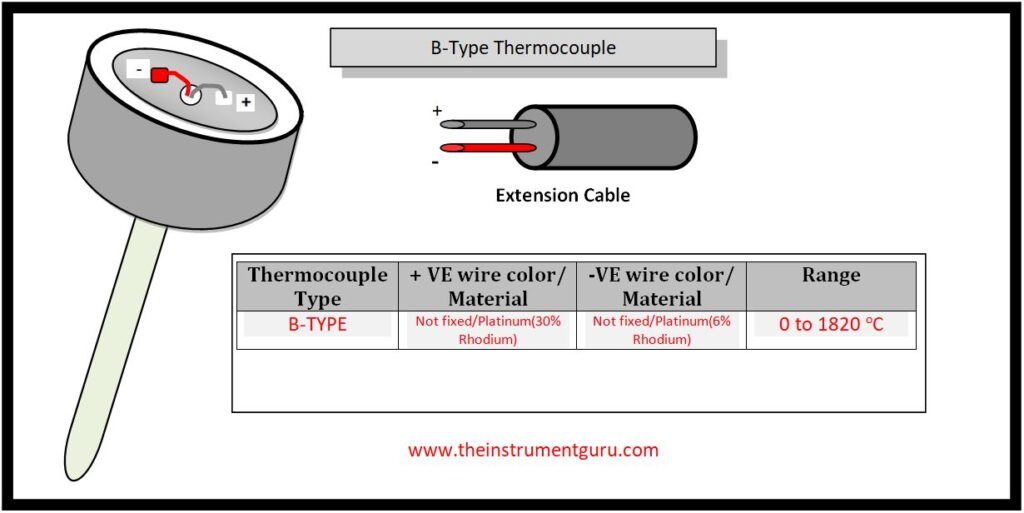




Type B thermocouples are used to measure temperatures up to 1800 °C. But the output of this thermocouple is less than that of type R and S thermocouples.
Thermocouple Extension Cable
A cable is used to show the indication of the thermocouple in the remote control room. The cables used in thermocouples come separately for each thermocouple and their color code is fixed. Their color code varies from standard to standard.
To use thermocouple, it is necessary that the type of thermocouple should be the same type of thermocouple cable. For example, for k-type thermocouple, it is necessary to use k-type cable.
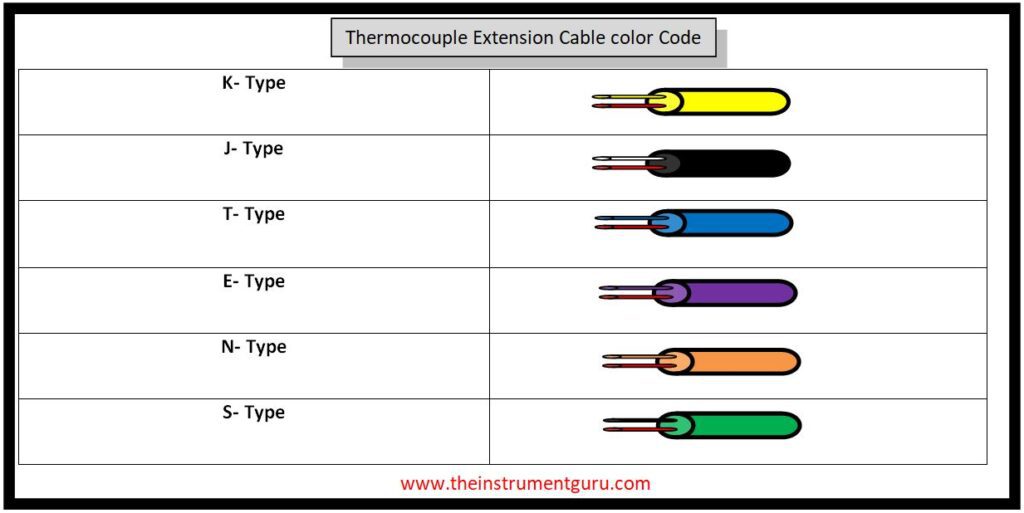




Read Also
Watch this topic On youtube